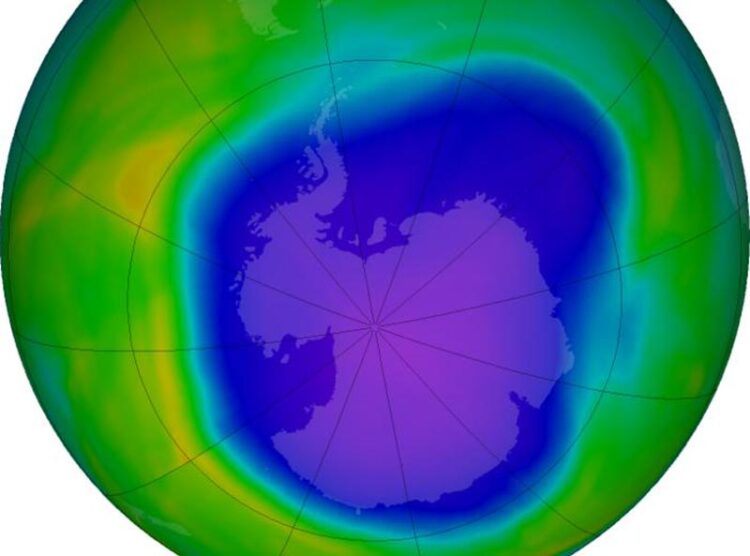Study highlights need to keep an eye on the ozone hole

Large ozone hole recorded on 3 October, 2022 Antarctic ozone hole by NASA Ozone Watch.
Credit: NASA Ozone Watch
Despite public perception, the Antarctic ozone hole has been remarkably massive and long-lived over the past four years, University of Otago researchers believe chlorofluorocarbons (CFCs) aren’t the only things to blame.
In a study, just published in Nature Communications, the group analysed the monthly and daily ozone changes, at different altitudes and latitudes within the Antarctic ozone hole, from 2004 to 2022.
Lead author Hannah Kessenich, PhD candidate in the Department of Physics, says they found there is much less ozone in the centre of the ozone hole compared to 19 years ago.
“This means that the hole is not only larger in area, but also deeper throughout most of spring.
“We made connections between this drop in ozone and changes in the air that is arriving into the polar vortex above Antarctica. This reveals the recent, large ozone holes may not be caused just by CFCs,” she says.
While the Montreal Protocol on Substances that Deplete the Ozone Layer, which has been in place since 1987, regulates the production and consumption of man-made chemicals known to deplete the ozone, the researchers believe other complex factors are also contributing to the ozone hole.
“Most major communications about the ozone layer over the last few years have given the public the impression that the ‘ozone issue’ has been solved.
“While the Montreal Protocol has vastly improved our situation with CFCs destroying ozone, the hole has been amongst the largest on record over the past three years, and in two of the five years prior to that.
“Our analysis ended with data from 2022, but as of today the 2023 ozone hole has already surpassed the size of the three years prior – late last month it was over 26 million km2, nearly twice the area of Antarctica.”
Ms Kessenich believes understanding ozone variability is important because of the major role it plays in the Southern Hemisphere’s climate.
“We all know about the recent wildfires and cyclones in Australia and New Zealand and the Antarctic ozone hole is part of this picture.
“While separate from the impact of greenhouse gases on climate, the ozone hole interacts with the delicate balance in the atmosphere. Because ozone usually absorbs UV light, a hole in the ozone layer can not only cause extreme UV levels on the surface of Antarctica, but it can also drastically impact where heat is stored in the atmosphere.
“Downstream effects include changes to the Southern Hemisphere’s wind patterns and surface climate, which can impact us locally.”
She is quick to allay fears about extreme UV rays, though.
“New Zealanders need not worry about applying extra sunscreen this year as the Antarctic ozone hole is generally not open above New Zealand – it is mostly located directly over Antarctica and the South Pole.”
Journal: Nature Communications
DOI: 10.1038/s41467-023-42637-0
Article Title: Potential drivers of the recent large Antarctic ozone holes
Article Publication Date: 21-Nov-2023
All latest news from the category: Physics and Astronomy
This area deals with the fundamental laws and building blocks of nature and how they interact, the properties and the behavior of matter, and research into space and time and their structures.
innovations-report provides in-depth reports and articles on subjects such as astrophysics, laser technologies, nuclear, quantum, particle and solid-state physics, nanotechnologies, planetary research and findings (Mars, Venus) and developments related to the Hubble Telescope.
Newest articles

Recovering phosphorus from sewage sludge ash
Chemical and heat treatment of sewage sludge can recover phosphorus in a process that could help address the problem of diminishing supplies of phosphorus ores. Valuable supplies of phosphorus could…

Efficient, sustainable and cost-effective hybrid energy storage system for modern power grids
EU project HyFlow: Over three years of research, the consortium of the EU project HyFlow has successfully developed a highly efficient, sustainable, and cost-effective hybrid energy storage system (HESS) that…

After 25 years, researchers uncover genetic cause of rare neurological disease
Some families call it a trial of faith. Others just call it a curse. The progressive neurological disease known as spinocerebellar ataxia 4 (SCA4) is a rare condition, but its…





















